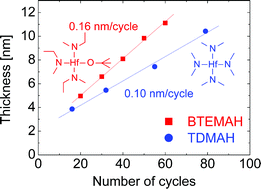Atomic layer deposition of hafnium oxide from tert-butoxytris(ethylmethylamido)hafnium and ozone: rapid growth, high density and thermal stability
Abstract
HfO2 thin films were grown by

* Corresponding authors
a
Department of Materials Science and Engineering, Inter-university Semiconductor Research Center, Seoul National University, Seoul, Korea
E-mail:
cheolsh@snu.ac.kr
Fax: +82 2 884 1413
Tel: +82 2 880 7535
b School of Chemical & Biological Engineering, Konkuk University, Seoul, Korea
HfO2 thin films were grown by

 Please wait while we load your content...
Something went wrong. Try again?
Please wait while we load your content...
Something went wrong. Try again?
M. Seo, Y. Min, S. K. Kim, T. J. Park, J. H. Kim, K. D. Na and C. S. Hwang, J. Mater. Chem., 2008, 18, 4324 DOI: 10.1039/B806382F
To request permission to reproduce material from this article, please go to the Copyright Clearance Center request page.
If you are an author contributing to an RSC publication, you do not need to request permission provided correct acknowledgement is given.
If you are the author of this article, you do not need to request permission to reproduce figures and diagrams provided correct acknowledgement is given. If you want to reproduce the whole article in a third-party publication (excluding your thesis/dissertation for which permission is not required) please go to the Copyright Clearance Center request page.
Read more about how to correctly acknowledge RSC content.
 Fetching data from CrossRef.
Fetching data from CrossRef.
This may take some time to load.
Loading related content
